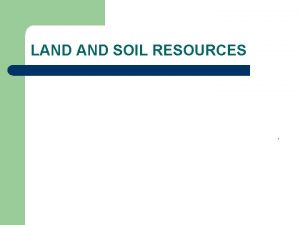LAND RESOURCES PRACTICE THE FOLLOWING MULTIPLE CHOICE QUESTIONS













- Slides: 13

LAND RESOURCES PRACTICE THE FOLLOWING MULTIPLE CHOICE QUESTIONS IN PREPARATION FOR THE UPCOMING TEST

1. According to the US Department of Agriculture, which of the following practices is most consistent with the production of organic crops ? A. Using biologic controls such as pheromones to disrupt insect mating cycles B. Using genetically modified plant varieties that kill insects that chew their leaves C. Using sodium nitrate as a fertilizer on green leafy vegetables D. Using strychnine to prevent buildup of aphid populations in field crops E. Using sewage sludge to improve the fertility and structure of soil

2. A major environmental problem arising from feedlots is A. Increased incidences of disease such as Lyme disease and botulism in livestock production B. Increased use of antibiotics & increasing livestock resistance to these antibiotics C. Damaged soil that will never be able to grow food crops D. Climate change arising from increasesd carbon dioxide production E. Pollution of surface and groundwater, resulting in eutrophication

3. Sustainable mineral use and a longer projected lifetime for scarce minerals can be achieved with all of the following, except A. Reuse & recycling B. exploring for new reserves C. Increasing demand lowering prices for products using these minerals D. Researching more efficient and environmentally friendly E. extraction techniques Finding more available substitutes for scarce minerals

4. Environmentalists oppose the mining of Antarctic mineral resources because A. The existence of valuable mineral deposits I the Antarctic environment is unlikely B. The Antarctic environments is fragile and extremely vulnerable to the disturbance that would accompany development C. Currently known world reserves of important metals and oil are considered inexhaustible D. The demand for minerals is expected to decline as the world’s nations become more industrialized E. Territorial claims to Antarctica are unresolved

5. Conservation tillage is an agricultural practice that A. Maximizes intact ground cover to prevent soil erosion B. Conserves all native grasses in order to promote intact ecosystems C. Removes all weeds and competing plants in order to maximize crop yields D. Promotes polyculture, including cattle grazing, to naturally fertilize fields E. Reduces the effects of climate change and desertification

6. Which of the following is a new process for removing heavy metals and acid sulfate pollution from mine leachate water? A. Filtration followed by sedimentation B. Heavy metal reduction C. deep-well injection D. sulfate-reducing bacteria E. Treatment with chlorine and/or ozone

7. Critics of the Green Revolution most often cite A. The increased practice of monocropping, leading to increased risk of overall crop failure without the widespread use of pesticides B. New strains of GMO seeds that might cause human health problems C. The overabundance of food produced, leading to unusually low food prices D. The necessity for seed banks, now that we are using so many varied seeds to grow crops worldwide E. New strains of GMO seeds that have transgenes, whichmay escape into nature, causing unknown and possibly harmful effects

8. The Green Revolution has led to increased yields, but also increased monoculture planting. Which of the following is most likely to be the direct result of lack of genetic diversity in a food crop such as corn? A. Decreased dependence on chemical fertilizers B. Increased resistance to pests C. Decreased kernel size D. Decreased number of people fed E. Increased susceptibility to plant disease

9. Which of the following is an environmental problem associated with abandoned coal mines? A. Air pollution caused by smog from ozone formation B. Alkaline solutions that pollute streams C. Acid drainage due to leaching of spoil heaps by rain water D. Released nutrients that cause eutrophication in to streams E. Thermal pollution of streams in the area

10. Which of the following procedures would be best for remediating the effects of soil salinization? A. Adding pools of water to soak into the soil, removing the salt from the surface B. Application of superphosphate to increase soil fertility C. Addition of clay to increase soil water holding capacity D. Installing a drainage system and adding large amounts of water to leach out the salts E. Application of broad-spectrum biocides to kill microorganisms

11. Which of the following is most likely to occur in afforested region that has been recently clear-cut? A. The average depth of the topsoil will increase B. The water temperature in streams running through the region will decrease C. The frequency of landslides will decrease D. Volume of runoff after rains will decrease E. The concentration of nitrates & silt in streams running through the region will increase

12. Fragmenting one large park or preserve into many small parks with roads, farms, and human habitation in between them is most likely to lead to which of the following? A. Stabilization of microclimates B. Decrease in the proportion of edge habitat C. Increase in gene flow within a species D. Reduction in species diversity E. Increase in population size of top carnivores
 The plot of oedipus deals mainly with
The plot of oedipus deals mainly with Oedipus rex ap multiple choice questions
Oedipus rex ap multiple choice questions Osslt grammar practice with answers
Osslt grammar practice with answers When we take a census, we attempt to collect data from
When we take a census, we attempt to collect data from Ap lang mcq
Ap lang mcq Ap lit practice mcq
Ap lit practice mcq Hsc multiple choice practice
Hsc multiple choice practice How to write multiple choice questions
How to write multiple choice questions Tarry a little there is something else
Tarry a little there is something else The story of an hour selection test
The story of an hour selection test What is stimulus in mcq
What is stimulus in mcq Which conjunctive adverb best completes the sentence?
Which conjunctive adverb best completes the sentence? How to create multiple choice questions in word 2007
How to create multiple choice questions in word 2007 Stimulus-based questions examples
Stimulus-based questions examples
























